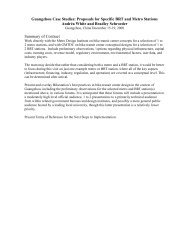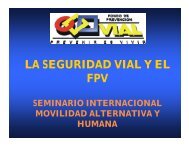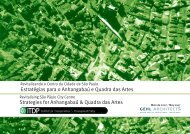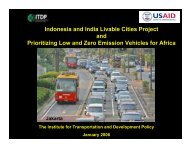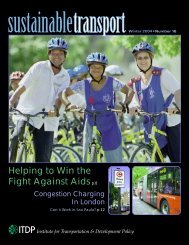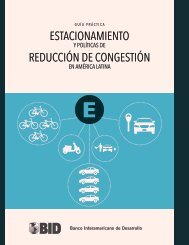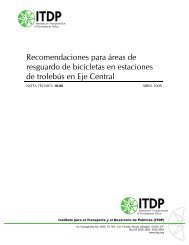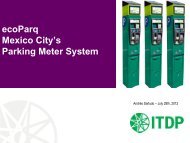Making TransJakarta a World Class BRT System - ITDP | Institute for ...
Making TransJakarta a World Class BRT System - ITDP | Institute for ...
Making TransJakarta a World Class BRT System - ITDP | Institute for ...
You also want an ePaper? Increase the reach of your titles
YUMPU automatically turns print PDFs into web optimized ePapers that Google loves.
encumber the <strong>TransJakarta</strong> <strong>BRT</strong> system with an inefficient structure just because the<br />
monorail system can never become operationally self-financing.<br />
In our opinion, the best scenario would be to change <strong>TransJakarta</strong> from a BP to a PT, a<br />
publicly-owned company. <strong>TransJakarta</strong> ideally would have a Board of Directors chaired<br />
by the Governor, with representation by the Managing director of <strong>TransJakarta</strong>, DisHub,<br />
the City Planning office, the Office of Landscape Architecture, DisHub, and Public<br />
Works. If the national government becomes involved in financing future <strong>TransJakarta</strong><br />
corridors, representatives of the national government could also be included in the<br />
<strong>TransJakarta</strong> Board. (In Bogota, the national government has just joined the<br />
TransMilenio board due to the receipt of a large loan from the <strong>World</strong> Bank via the<br />
national government).<br />
This new PT should completely replace the current BP, which should be abolished.<br />
Otherwise, additional administrative confusion will result. This new PT would directly<br />
control the farebox revenue but could also receive funds from other government sources.<br />
Responsibility <strong>for</strong> the planning and design of the future corridors would be transferred<br />
from DisHub to <strong>TransJakarta</strong>, and the power to regulate the bus routes in the<br />
<strong>TransJakarta</strong> corridors would also be transferred from DisHub. It would also directly<br />
negotiate all operating contracts <strong>for</strong> both trunk line and feeder bus line operators, and<br />
ticketing system operators, and pay them directly from the proceeds of the farebox<br />
revenue. <strong>TransJakarta</strong> would then need to hire competent staff to fulfill these new<br />
responsibilities, perhaps some of them coming from DisHub or being seconded from<br />
DisHub.<br />
The second best scenario would be to leave bus route regulation with DisHub, but<br />
transfer planning and design to a new PT <strong>TransJakarta</strong>. Third best option would be to<br />
transfer bus route regulation to a new PT <strong>TransJakarta</strong> but leave planning and design with<br />
DisHub, and replace the current leadership of DisHub with more technically advanced<br />
personnel.<br />
II.3. <strong>TransJakarta</strong> and Trunk Line Operations<br />
II.3.a. Corridor I Trunk Line Operations<br />
For the first <strong>TransJakarta</strong> corridor, BP <strong>TransJakarta</strong> had only just been created, so an<br />
operating contract <strong>for</strong> Corridor I was basically set up by DisHub with a single private<br />
consortium called PT JET (Jakarta Ekspress Trans). PT. JET was created two days be<strong>for</strong>e<br />
the bus rapid transit system opening out of the largest <strong>for</strong>mer bus operators in the first<br />
<strong>TransJakarta</strong> corridor.<br />
PT JET was created out of many of the existing operators in corridor so they would not<br />
fully resist implementation but would support the new <strong>TransJakarta</strong> system.<br />
Final Recommendations <strong>for</strong> <strong>TransJakarta</strong>, p. 29




